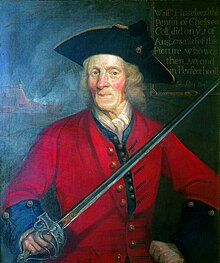| Corps of Invalids | |
|---|---|
 William Hiseland in 1730. Though never a member of the Corps of Invalids, he fought in battle at the age of 89 and is shown here in the uniform of the Chelsea Pensioners – identical to that of the corps | |
| Active | 1688–1802 |
| Country |
|
| Branch | |
| Type | Infantry |
| Role | Garrison duty |
| Part of | Royal Hospital Chelsea |
The Corps of Invalids was a British unit that provided garrison troops for the defence of England and Great Britain between 1688 and 1802. The men and officers were all veterans of the British Army chosen by the commissioners of the Royal Hospital Chelsea to serve in lieu of a place at the hospital or receipt of a pension. The corps was rapidly expanded or decreased in size as needs arose and played a key role in regulating the manpower requirements of the British Army. The corps was organised into a number of independent companies that were garrisoned at key points in the country, freeing up units of the regular army for service overseas. The men were generally those who were too old or wounded to serve in the regular forces and most served at least six years with the corps. In the early years they wore a grey uniform but later wore the same red coat with blue facings as worn by the patients of the Chelsea Hospital.
The original three companies of the corps were raised by James II in 1688 to bolster his defences against a feared invasion by William of Orange. However the units played no part in the defence of London during the Glorious Revolution of that year. William III disbanded the corps shortly afterwards but it was reformed in 1690 to provide manpower for the ongoing War of the League of Augsburg. The corps was reduced in 1703 under the Duke of Marlborough but expanded again to help defend against the threatened French invasion of Scotland in 1708. It was intended to expand the corps to 26 companies during the War of the Spanish Succession but after the Treaty of Utrecht it was reduced to just eight companies. Fears of another Jacobite invasion attempt caused the corps to be expanded to 26 companies during the early reign of George I and two companies garrisoned at Plymouth seem to have deterred the landing of the Duke of Ormonde there during the Jacobite rising of 1715.
The corps was maintained throughout the 18th century providing units to meet the requirements of the Seven Years' War, American War of Independence and the French Revolutionary Wars. A full regiment of the corps, Edmund Fielding's Regiment – later called the "Royal Invalids", was raised in 1719. In addition a detachment of 500 men were made available for service as marines at sea in 1740. By 1791 the corps numbered more than 7,000 men. In 1802 the corps was disbanded with able-bodied men being absorbed into the new Royal Garrison Battalions and ultimately into regular line infantry regiments.